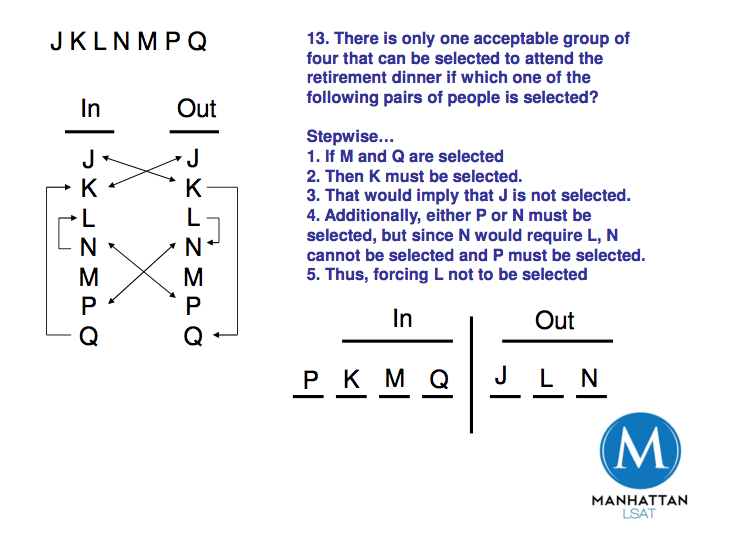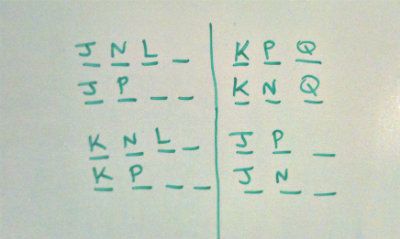Could someone explain question 13? If both M & Q are selected then the third person is K but wouldn't that leave space open for P or J? So how does this create one acceptable group of 4?
Thanks!!
LSAT Forum
9 postsPage 1 of 1
-

- ManhattanPrepLSAT1
-
Thanks Received: 1909
-
Atticus Finch

- Posts: 2851
- Joined: October 07th, 2009
Re: PT 9, Sec 3, Game 2
Here's a slide that should help walk you through question 13. Let me know if you still need some more help with it...


-

- noah
-
Thanks Received: 1192
-
Atticus Finch

- Posts: 1541
- Joined: February 11th, 2009
Re: Q13
Figured I'd put this in the right place...
ngogirl Wrote:The way I approached it was, I remembered the key deduction I arrived at with #10 which is P can never go with L, and Q can never go with J. So I tried finding some key inference with the answer choices, nothing worked so I did hypotheticals with the information I had for A through E and this is what I got:
(A) J__L__
(B) K__M__
(C) __ N L __
(D) K__ L Q
(E) K P M Q
So I picked E. It didn't take very long to do this.
-

- timmydoeslsat
-
Thanks Received: 887
-
Atticus Finch

- Posts: 1136
- Joined: June 20th, 2011

- Most Thanked

- First Responder
Re: Q13
noah Wrote:Figured I'd put this in the right place...ngogirl Wrote:The way I approached it was, I remembered the key deduction I arrived at with #10 which is P can never go with L, and Q can never go with J. So I tried finding some key inference with the answer choices, nothing worked so I did hypotheticals with the information I had for A through E and this is what I got:
(A) J__L__
(B) K__M__
(C) __ N L __
(D) K__ L Q
(E) K P M Q
So I picked E. It didn't take very long to do this.
I was doing this game earlier today and I wanted to clarify a point I believe ngogirl has misspoke about.
While it is true that K cannot go with J, it is not the case that P and L cannot go together.
We know that one of P and N must go in and one must go out. Had the condition of N ---> L been reversed, then it would be true that P could not go with L, however, with it being N ---> L....there is nothing precluding P and L together, as this hypothetical shows:
P L Q K ....... N J M
-

- ucsc24
-
Thanks Received: 0
-
Vinny Gambini

- Posts: 6
- Joined: April 16th, 2012
Re: Q13
I'm confused by this answer...
Can't it be K M Q P and K M Q L? So there's at least two acceptable answers to all of the options aren't there? So there's no right answer...
It states that N cannot be selected unless L is selected which is N-->L, but this does not mean that L cannot be selected by itself so there two acceptable groups of four for answer E. Or am i doing the conditional wrong?
Can't it be K M Q P and K M Q L? So there's at least two acceptable answers to all of the options aren't there? So there's no right answer...
It states that N cannot be selected unless L is selected which is N-->L, but this does not mean that L cannot be selected by itself so there two acceptable groups of four for answer E. Or am i doing the conditional wrong?
-

- timmydoeslsat
-
Thanks Received: 887
-
Atticus Finch

- Posts: 1136
- Joined: June 20th, 2011
- This post thanked 2 times.

- Most Thanked

- First Responder
Re: Q13
ucsc24 Wrote:I'm confused by this answer...
Can't it be K M Q P and K M Q L? So there's at least two acceptable answers to all of the options aren't there? So there's no right answer...
It states that N cannot be selected unless L is selected which is N-->L, but this does not mean that L cannot be selected by itself so there two acceptable groups of four for answer E. Or am i doing the conditional wrong?
Your second hypothetical does not have 1 of N and P.
-

- matthew.mainen
-
Thanks Received: 7
-
Jackie Chiles

- Posts: 45
- Joined: March 25th, 2011
Re: Q13
Is there a trick to get the ball rolling on how to think of this question?
What I ultimately came up with is I had a hunch that it had something to do with the rules:
N -> L
Q -> K
I noticed that N, Q would be an acceptable solution but it was not an option.
So from there I started playing with the contra positives of the two, and then it became clear that ~L-> P + M + Q - > K.
In order to get ~ L to set off the chain, you need M+Q, which is the right answer.
But I got to looking at this route by sheer luck.
When I get to one of these end game questions in a game similar to this, what are some of the things that I should immediately start thinking about?
What I ultimately came up with is I had a hunch that it had something to do with the rules:
N -> L
Q -> K
I noticed that N, Q would be an acceptable solution but it was not an option.
So from there I started playing with the contra positives of the two, and then it became clear that ~L-> P + M + Q - > K.
In order to get ~ L to set off the chain, you need M+Q, which is the right answer.
But I got to looking at this route by sheer luck.
When I get to one of these end game questions in a game similar to this, what are some of the things that I should immediately start thinking about?
-

- timmydoeslsat
-
Thanks Received: 887
-
Atticus Finch

- Posts: 1136
- Joined: June 20th, 2011
- This post thanked 1 time.

- Most Thanked

- First Responder
Re: Q13
For me, this game is quickly seeing how limited the possibilities are.
You have to place exactly three out, and you know that two of those three will be dual options of J/K and N/P.
I decided to run frames. You have a clean split of J in with N, then J in with P.
Then do K in with N, then K in with P.

So to finish up our framing, the best thing to do first is to attack each hypo with the N ---> L rule. So we will place L's where we see N in. Our next goal is to attack with the Q ---> K rule. Since we have not yet placed Q, we want to see where it is the case that K is out, as this will force Q out (contrapositive).

This will fill up our out column, which will force all other variables in the in column.
Notice that we do not have rules for what happens when K is in. So anything goes. Another concept to consider is that in a situation of a N ---> L rule...this rule becomes void when N is out. It is impossible for that rule to affect L.

So, when you see the absolute last hypo, you can see where we had a situation of K and P being in, and J and N being out.
Did we know what to do with N being out? Nope! The N ---> L rule is void. What about our Q ---> K rule? We know K must be in. This means that Q can go in or out! If Q is in, K will already be in. If Q is out, that does not force K out. So we can show that any combination of those three variables can be in and out.
This will allow us to quickly see that only one lineup can be produced with M and Q in.
You have to place exactly three out, and you know that two of those three will be dual options of J/K and N/P.
I decided to run frames. You have a clean split of J in with N, then J in with P.
Then do K in with N, then K in with P.

So to finish up our framing, the best thing to do first is to attack each hypo with the N ---> L rule. So we will place L's where we see N in. Our next goal is to attack with the Q ---> K rule. Since we have not yet placed Q, we want to see where it is the case that K is out, as this will force Q out (contrapositive).

This will fill up our out column, which will force all other variables in the in column.
Notice that we do not have rules for what happens when K is in. So anything goes. Another concept to consider is that in a situation of a N ---> L rule...this rule becomes void when N is out. It is impossible for that rule to affect L.

So, when you see the absolute last hypo, you can see where we had a situation of K and P being in, and J and N being out.
Did we know what to do with N being out? Nope! The N ---> L rule is void. What about our Q ---> K rule? We know K must be in. This means that Q can go in or out! If Q is in, K will already be in. If Q is out, that does not force K out. So we can show that any combination of those three variables can be in and out.
This will allow us to quickly see that only one lineup can be produced with M and Q in.
9 posts Page 1 of 1